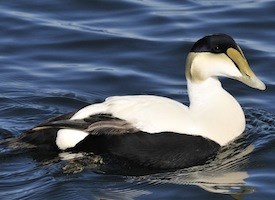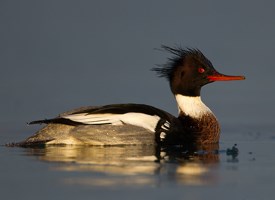By Tamsin Venn
One reason to go kayaking in the Northeast now is to see winter seabirds. Recently I took a trip with Mass Audubon experts to find and identify these winter visitors around the rocky tip of Cape Ann, Mass. We went via heated vans, but I plan to return by kayak now I know what to look for.
Cape Ann’s exposed granite shores with crashing waves, plus protected harbors, seaside ponds, and sand beaches provide good habitat and viewing for these hardy seabirds.
Here is a list of the birds we saw and those you can expect to see out offshore now.
1) Red-breasted Merganser. Identifiable by the Mohawk haircut and narrow, red bill. The females have a rusty head. The narrow, serrated bill enables this diving duck to stab at fish and hold it firm in its bill or else grind crustaceans.
2) Common Eider. Eiders float in big rafts of dark brown females and distinct males with black bellies and white backs. They are the biggest sea duck of all and so easy to pick out from the buffleheads. If you’re really lucky, you might see a King Eider.
3) The Bufflehead a.k.a. “marshmallow head” is aptly named, for its large white round head and how it pops up on the water. One of the smallest and endearing ducks, it dines on mollusks and clams and swallows pebbles to help grind them up.
4) Three types of scoters. Close to shore you will see the Black and White-winged Scoter. It is rare to see the Surf Scoter which feeds farther out to sea. The key to IDing scoters is in the dabs of white on the cheeks.
5) The Double-crested Cormorant sprouts white feathers in the winter, but otherwise does not change dramatically from summer plumage. Fun detail, it sprouts two horn-like tufts at the top of its head in spring breeding season. It is easy to find by the orange bill and low stance in the water.
6) One of the biggest delights to see is the multi-colored, sea hardy Harlequin Duck, Latin name Histrionicus histrionicus. It is one of three rapid obligates in the world. That means it needs rushing water to feed so you often see them on rapidly flowing freshwater streams in summer. Along shore, they like the really rocky spots and can handle the strong water. Crashing waves break over them and they just sit there unperturbed.
7) Rarer to spot is the Long-tailed Duck, a striking bird with black and white markings; Horned Grebe; Lesser Scaup whose head may be nestled into its feathers and hard to ID because head shape is how you distinguish a Greater from a Lesser Scaup. Also, Hooded Merganser, Common Merganser, Ring-necked Duck, American Coot, Northern Pintail.
8) Scuttling along the rocks and seaweed you’ll find the Purple Sandpiper, so named for its slight purplish gloss. It’s the only sandpiper that sticks around in winter and is found mostly only on wave-washed rocks vs. sandy beaches or mudflats.
9) Shift your gaze out to sea and you might spot a Northern Gannett patrolling high above the water, steadily, floppily, winging by with its large wingspan and black wing tips. It’s common on open ocean, rare on land.
10) And you’re bound to see Herring, Great Black-backed, Ring-billed, and Bonaparte’s Gulls and of course the delightful Loons in their winter plumage.
11) If in doubt about the ID, check out the range maps in your guidebook and the blue bands for winter habitat. Happy winter paddling and bird watching!



